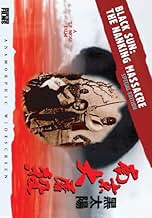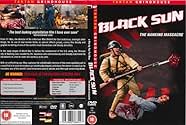Agrega una trama en tu idiomaIn 1937, Japanese troops raid the Chinese city of Nanking to execute a planned massacre by subjecting over 300,000 helpless civilians to various tortures and atrocities before slaughtering t... Leer todoIn 1937, Japanese troops raid the Chinese city of Nanking to execute a planned massacre by subjecting over 300,000 helpless civilians to various tortures and atrocities before slaughtering them all.In 1937, Japanese troops raid the Chinese city of Nanking to execute a planned massacre by subjecting over 300,000 helpless civilians to various tortures and atrocities before slaughtering them all.
- Dirección
- Guionista
- Elenco
- Dirección
- Guionista
- Todo el elenco y el equipo
- Producción, taquilla y más en IMDbPro
Opiniones destacadas
Arriving at my door, this video, which I had procured from E-Bay.com has many extras and features and is very-well put together, but the film itself, unbeknownst to me at that time, would prove to be my undoing: Quite by accident I'd come upon a dread vision more fantastic than anything from out of Dante; putrified, bodies piled in heaps on beaches in the Chinese province of Xixioung, a, like so many flesh-balloons ripening and bursting in the afternoon sun. On this the camera lingers, unflinchingly -- Pop! a corspe, bursting at the seems, abruptly inflates and then pops open strewing it's organs amid a splash of half-uncoagulated blood, and then another, and then another...
Finally, toward evening, this ranch of carnage is set ablaze and we are treated to a symphony of sickening popping sounds and the abysmal sight of what can best be described as a field of human popcorn yielding it's unwholesome fruits. The heat from the resulting conflagration, you see, creates pressure within the floury endosperm of corpse-meat, causing it to explode, and, horrific to relate, turn itself inside out.
In addition to a severe case of panic/anxiety disorder, a screening of these terrors, celebrated in this film, "Rape of Nanking-- Solar Disc of Umbra" (literal translation) resulted in something my doctor has told me is called "restrcutring cognitive distortion", a condition wherein brain fluid backflows (refluxes) into the lobular cavities, sometimes getting into the ears, occasionally, I understand, even into the mouth. It produces ultra-intense headaches at least twice a week. Actually. before I started taking Pantroprazole, it was occurring not just twice a week, but more than twice a day. In addition to the nightmares, in a very small percentage of people, including me, it produces nearly impossible to describe creepy feelings like something besides just brain fluid is crawling around in my head.
Additionally, it also seems to produce, or, at least, trigger creepy feelings and pressure in my head that vaguely resemble the anxiety I experienced when first watching the terrific imagery presented in this title, but are unlike any headache I've ever had. My doctor says that those headaches have nothing to do with the Nanking Massacre, but I don't believe him.
And when dead bodies start erecting themselves, and march out of their graves, or people with crippled skeletons are restored to perfect form, CNN will be there ...
Finally, toward evening, this ranch of carnage is set ablaze and we are treated to a symphony of sickening popping sounds and the abysmal sight of what can best be described as a field of human popcorn yielding it's unwholesome fruits. The heat from the resulting conflagration, you see, creates pressure within the floury endosperm of corpse-meat, causing it to explode, and, horrific to relate, turn itself inside out.
In addition to a severe case of panic/anxiety disorder, a screening of these terrors, celebrated in this film, "Rape of Nanking-- Solar Disc of Umbra" (literal translation) resulted in something my doctor has told me is called "restrcutring cognitive distortion", a condition wherein brain fluid backflows (refluxes) into the lobular cavities, sometimes getting into the ears, occasionally, I understand, even into the mouth. It produces ultra-intense headaches at least twice a week. Actually. before I started taking Pantroprazole, it was occurring not just twice a week, but more than twice a day. In addition to the nightmares, in a very small percentage of people, including me, it produces nearly impossible to describe creepy feelings like something besides just brain fluid is crawling around in my head.
Additionally, it also seems to produce, or, at least, trigger creepy feelings and pressure in my head that vaguely resemble the anxiety I experienced when first watching the terrific imagery presented in this title, but are unlike any headache I've ever had. My doctor says that those headaches have nothing to do with the Nanking Massacre, but I don't believe him.
And when dead bodies start erecting themselves, and march out of their graves, or people with crippled skeletons are restored to perfect form, CNN will be there ...
I really don't know what to think of this movie. I would say that, after the first 30 minutes I was ready to dismiss it. I don't think it's inability to pick a genre is a virtue (though I think it could have been). I also think the film comes off way too much like a propaganda film for the People's Republic. It seems to suggest that the "Rape of Nanking" was some kind of secret. Well, for whatever reason, I knew about it already, and so I thought that attitude was rather odd. Another random thing: that introduction is bizarre. There must have been 30-40 cuts in 90 seconds. That's just insane. It didn't work in my mind. But anyway, the director has more balls than any American or even just any mainstream filmmaker would in depicting the atrocities. Though an atrocity doesn't automatically make a good film, I still find this attempt at truly conveying the horror commendable. And further, there is no imposed happy ending, unlike western films that try to deal with these things. For that, I think I can forgive the stylistic difficulties.
THE NANKING MASSACRE is another solid piece of work from T.F. Mou regarding the atrocities that the Japanese brought upon the Chinese in WWII. Personally, I felt that this installment lacked the punch of MEN BEHIND THE SUN, but was still very effective in trying to relate the horrors of war and oppression. There are a few "gore" scenes, but to be quite honest, they almost come off a little comically (or i'm just sick...). I found the "forced abortion" and the "baby in the rice steamer" scenes to be pretty hilarious, though I'm sure they weren't meant to be - the FX just looked silly and not horrifying. That's not to make light of the film itself or of what actually happened in China at that time period. All-in-all I found the film to be very moving, and should really be looked at as a history lesson more than as a horror film. I know that "extreme" horror fans will seek this and MEN BEHIND THE SUN out for their notorious reputations as "shocking" and "horrific" gore films, but I think that those who are just looking for blood-and-guts will be severely disappointed. As I stated before, these are neither horror nor gore films, but a fictionalized recreation of events. Either way, I feel that they are both good films, although I prefer MEN BEHIND THE SUN over THE NANKING MASSACRE. Definitely not for everyone due to some graphic material, but highly recommended 7 1/2 out of 10
It's not often you hear about the Japanese atrocities committed against the Chinese. Black Sun : The Nanking Massacre unflinchingly tells the true story of the over 300,000(that's 300,000!!!!) Chinese people who were brutally killed by the occupying Japanese army. Mixed with real film footage and photographs of the actual events, the film really shows the atrocities of war. It's mostly told from the Japanese point of view, and several conversations between Japanese commanders and soldiers are chilling. There are some exploitative gross out moments, like an unborn baby being pulled out of a pregnant woman's stomach via bayonette...but it always feels true. There are so many scenes of crowds being machine gunned down that you can be desensitized pretty early on in the film. The scary thing is, is the Japanese really WERE this barbaric. They slaughtered babies, infants, children, women, men and monks alike. The scene of hundreds of bodies being burned on the beach is a truly haunting moment. While it is an absolute must see for war film fans or historians...the film, however, is gory enough to make splatter fans happy.
This is worth viewing and the DVD Special edition well worth buying for the 'extras', but there are one or two problems. I think the main difficulty is that the director has available to him awful, original footage of events and decides to mix these in with what for the main part can only be described as exploitative material. Nothing wrong with a good old exploitation movie of course but here the, probably cheaply done, massed bodies and brutal slayings look nothing compared to the original sickening footage. There are moments like the burning of the bodies at the river's edge that are undoubtedly powerful but for the most part we are only too aware that this is a one event movie spun out for the sole reason of showing the spilling of blood and guts and getting across the message that the Japanese are evil. Having said all that the DVD distributors have exceeded themselves and included notable items including a most illuminating 1944 US propaganda film, 'Why We Fight: The Battle Of China' - not to be missed.
¿Sabías que…?
- TriviaThis film's closing epilogue states: "After Nanking was occupied by the Japanese Army, massive burning, killing, raping and plundering continued for 6 weeks. Males, females, old, and young - none were spared. The atrocities were even worst than that shown in this film. This was not a war. It was an intentional, planned, and organized massacre."
- ConexionesFollows Hei tai yang 731 (1988)
Selecciones populares
Inicia sesión para calificar y agrega a la lista de videos para obtener recomendaciones personalizadas
- How long is Men Behind the Sun 4?Con tecnología de Alexa
- What are the differences between the HongKong Version and the US Version?
Detalles
- Fecha de lanzamiento
- País de origen
- Idioma
- También se conoce como
- Men Behind the Sun 4
- Productora
- Ver más créditos de la compañía en IMDbPro
Contribuir a esta página
Sugiere una edición o agrega el contenido que falta

Principales brechas de datos
By what name was Hei tai yang: Nan Jing da tu sha (1995) officially released in Canada in English?
Responda







